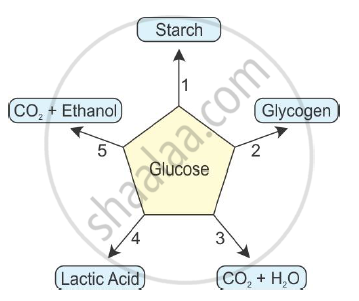Advertisements
Advertisements
Question
What advantage over an aquatic organism does a terrestrial organism have with regard to obtaining oxygen for respiration?
Solution 1
Terrestrial organisms take up oxygen from the atmosphere whereas aquatic animals obtain oxygen from water. Air contains more O2 as compared to water. Since the content of O2 in air is high, the terrestrial animals do not have to breathe faster to get more oxygen. Therefore, unlike aquatic animals, terrestrial animals do not need adaptations for gaseous exchange.
Solution 2
APPEARS IN
RELATED QUESTIONS
Given below are the end products of different reactions involving glucose.

Write the reaction number in front of the following:
(i) Anaerobic reaction =
(ii) Reaction in the human muscles =
(iii) Aerobic respiration =
(iv) Reaction in the plant cells =
(v) Reaction in the liver
The mountaineers carry oxygen with them because ______.
What would happen if all the green plants disappear from the earth?
Which of the following is the correct statement regarding bile?
Name the process by which plant parts like roots, stems, and leaves get oxygen required for respiration.
Name the pores in a leaf through which respiratory exchange of gases takes place.
What is the name of tiny air-sacs at the end of smallest bronchioles in the lungs?
In the lungs what substance is taken into the body?
Name the type of respiration in which the end product is:
C2H5OH and CO2
Give one example where such a respiration can occur.
Describe the process of respiration in Amoeba. State whether it is anaerobic respiration or aerobic respiration.
Describe the process of respiration in fish.
Describe the process of respiration in the following part of a plant:
Leaves
Explain how, it would benefit deep sea divers if humans also had gills.
Describe the exchange of gases which takes place in the leaves of a plant
(a) during daytime, and (b) at night.
When air is blown from mouth into a test-tube containing lime water, the lime water turns milky due to the presence of:
Which of the following is the correct sequence of air passage during inhalation?
(a) nostrils → larynx → pharynx → trachea → lungs
(b) nasal passage → trachea → pharynx → larynx → alveoli
(c) larynx → nostrils → pharynx → lungs
(d) nostrils → pharynx → larynx → trachea → alevoli
Which of the following statements are correct?
(i) pyruvate can be converted into ethanol and carbon dioxide by yeast
(ii) fermentation takes place in the case of aerobic bacteria
(iii) fermentation takes place in mitochondria
(iv) fermentation is a form of anaerobic respiration
Which of the following statements are true about respiration?
(i) during inhalation, ribs move inward and diaphragm is raised.
(ii) the gaseous exchange takes place in the alveoli.
(iii) haemoglobin has greater affinity for carbon dioxide than oxygen.
(iv) alveoli increase surface area of the exchange of gases
One of the following animals does not use tracheae as the respiratory organs. This animal is:
There are five animals P, Q, R, S and T. The animal P always lives in water and has gills for breathing. The animal Q can stay in water as well as on land and can breathe both, through moist skin and lungs. The animal R lives in soil and breathes only through its skin. The animal S lives on land and breathes through spiracles and tracheae. And animal T lives in water and breathes through its cell membrane.
(a) Which of the animals could be Amoeba?
(b) Which of the animals could be frog?
(c) Which animal could be fish?
(d) Which animal could be grasshopper?
(e) Which animal could be earthworm?
What happens to the glucose which enters the nephron tubule alongwith the filtrate?
Answer the following in one word.
What is the muscular sheet below the lungs called?
Choose the odd one out in the following groups of four items each:
Ethyl alcohol, Carbon dioxide, Starch, Oxygen
Name the body structure concerned with the given functional activity:
Combines with the oxygen in the lungs.
Given below is an example of certain structure and its special functional activity:
"Kidney and excretion".
Fill in the blanks on a similar pattern.
Diaphragm and _____________.
Given below is an overall chemical reaction of a certain process:
C6H12O6 →LacticAcid+2ATP+Heat energy
Name the process.
With regard to the respiratory system and the process of respiration in man, answer the following question:
What is meant by :
- Residual air and
- Dead air space
Answer the following question.
A gas is released during photosynthesis. Name the gas and also state the way by which the gas is evolved.
Answer the following question.
How is O2 and CO2 transported in human beings?
____________ refers to a biochemical process of oxidation of organic compounds in an orderly manner for the liberation of chemical energy in the form of ATP.
Respiration refers to ____________.
The major fraction of CO2 released during cellular respiration is transported by the blood to the lung capillaries ______
______ refers to the physical process by which gaseous exchange takes place between the atmosphere and the lungs.
The Figure shown below represents an activity to prove the requirements for photosynthesis. During this activity, two healthy potted plants were kept in the dark for 72 hours. After 72 hours, KOH is kept in the watch glass in setup X and not in setup Y. Both these setups are air tight and have been kept in light for 6 hours. Then, Iodine Test is performed with one leaf from each of the two plants X and Y.

The function of KOH is to absorb ______.
Explain the three pathways of breakdown in living organisms.
Yeast is used in wine and beer industries because it respires
Mark the following statement as True or False. Correct the false statement.
Insects have spiracles on the lower surface of the body.
